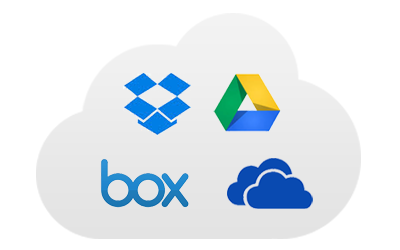What Enterprises Really Need
And File Sharing Cloud Services Are Missing That Point

During the last few years, file sharing cloud services are taking the world by storm, revealed its latest developments in its attempt to build a product that gains widespread and sanctioned use within businesses. Dropbox is already a force to be reckoned with inside enterprises. It claims that 97% of the Fortune 500 and 4 million individual businesses use its product in some way. But this is an opportunistic use of statistics and pays scant regard to the fact that a massive proportion of this enterprise use comes via so-called “shadow IT” where employees go around enterprise policies and procedures to use the product.
Shadow IT is, of course, a natural response from business users who have grown tired of what they see as a continual stonewalling by corporate IT. Every time they want to achieve a particular outcome, IT stands up and reads a list of reasons why said outcome is impossible – security, data leakage, regulatory compliance are oft-heard reasons for IT inflexibility. In response to this, business users find backdoor ways of achieving what they’re looking for; one of the most widespread symptoms of this shadow IT is the growing use of Dropbox within organizations for quick and easy file sharing. Dropbox has in recent months realized that while this massive growth of users looks good as a raw number, it needs to find ways to convert this use into more lucrative revenue streams via the enterprise. In doing so it has rolled out the aptly named Dropbox for Business. Dropbox has been listening to its enterprise customers and has made some attempts to deliver enterprise-grade functionality – visibility, central IT provisioning, audit and sharing controls have all been delivered. But the big hoopla recently focused on something of little importance to enterprise IT decision makers. The big news was – wait for it – a drop down menu. Essentially this drop down menu allows for a single point of access to two different worlds – an end user’s personal Dropbox files, and the corporate files they have access to.

In a blog post announcing the launch, Dropbox CEO Drew Houston spoke about the reasons for the launch:
just as people often work at home, they also want to have their personal files with them at the office. With only one Dropbox, users wound up putting their personal files in their Dropbox for Business. We needed to build a way to help people keep their stuff separate, but still make both sets available from everywhere.
So what’s not to like? This is great for the users isn’t it? Well yes it is, it’s a lovely piece of functionality that will make users happy. But that’s not the point. While some tech blogs gushed about the change, this move really doesn’t help Dropbox with its core problem. It’s already beloved, hence its hundreds of millions of users. It isn’t, however, loved by enterprise IT folks and this is why it hasn’t managed to build enterprise adoption the way that a more enterprise focused service like Box.com has.
Now there is some more robust enterprise stuff in the release that is good to see: sharing audit logs, two factor authentication and remote wipe for example.
Yet lacking more demanding features such as handing of file metadata, efficient navigation hierarchy for large document libraries, control for multiple users accessing the same files, referencing support for engineering and architecture documents such as CAD and other complex design files, easier security features such as security groups, propagation, append.
Don't get me wrong, file sharing cloud services are the future. Even with a traditional server, most businesses want to enable remote access and off-site backup, which is likely to involve the cloud in one way or another. At ACMSoft, we believe that Microsoft will integrate cloud storage solutions into Windows Server eventually, blurring the line between a traditional server and cloud storage services. As Google and other large companies work to innovate the cloud storage field and create more business-oriented cloud storage solutions, we think that the pros of the cloud will start to easily outweigh the advantages of a traditional server. For now, most organizations will benefit from a server.
Parts of this document is referring to the original document written by Ben Kepes...
Ben Kepes is a technology evangelist, an investor, a commentator and a business adviser. Ben covers the convergence of technology, mobile, ubiquity and agility, all enabled by the Cloud. His areas of interest extend to enterprise software, software integration, financial/accounting software, platforms and infrastructure as well as articulating technology simply for everyday users. Read more about Ben here.